We all know the story: after the Fall, when, as the King James Bible puts it, ‘the whole earth was of one language, and of one speech’, the human race built a city in the land of Shinar. At the centre of this city was the Tower of Babel. As the famous illustration in Athanasius Kircher’s book imagines, the soaring edifice reached up beyond the clouds, a monument to human ambition. God was scandalised. ‘Go to,’ He said. ‘Let us go down, and there confound their language, that they may not understand one another’s speech.’ God cursed humans to misunderstanding; he cursed us to translation.
For the past eight centuries, scholars at Oxford have been picking up the pieces – and in their libraries have slowly but surely raised a new Babel, book by book. Now visitors to the Weston Library can see a selection of these polyglot treasures in ‘Babel: Adventures in Translation’, a thoughtful exhibition of books, ancient papyri and tablets, and contemporary translation-related ephemera that begins with Kirchner’s print and wends its way through the ages in an attempt to show what translation looks like. Although confounded (perhaps fittingly) by a touch of Babel-like confusion, without a clear physical or conceptual centre point, ‘Adventures in Translation’ demonstrates that the history of English literature, and of English itself, is inseparable from translation.
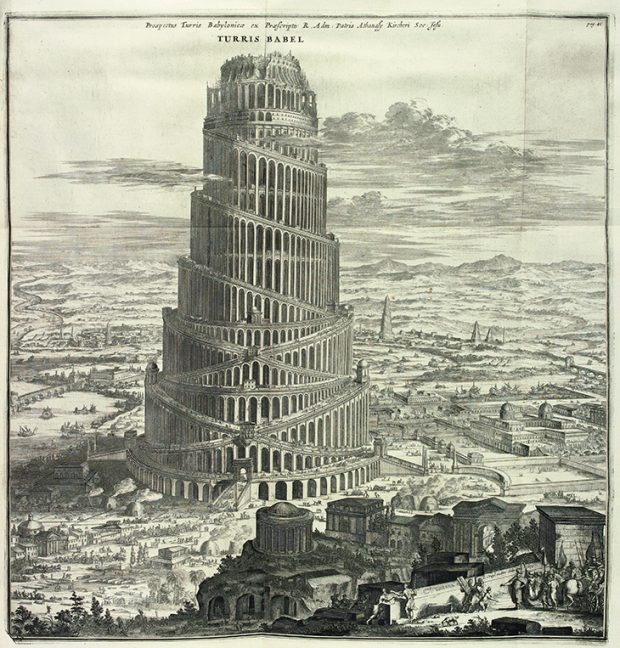
Engraving showing the Tower of Babel in Athanasius Kircher’s eponymous book of 1679. Bodleian Libraries, University of Oxford
The curators – a team of three Oxford academics and one working translator – cover some of the most important cases of and for translation in literary history. Chief among these is the Bible, and one of the more astonishing objects on display is a 1604 edition of the ‘Bishops’ Bible’ annotated in the spidery script of one of the 47 translators who produced the King James Version. This large book, open at the condemnation of Christ by Pontius Pilate, sits next to an ornate 18th-century Qur’an from southern India; the latter’s intricate geometrical patterns and flowing calligraphy, so rich in comparison to the gothic typeface of the Western volumes, makes the biblical text inextricable from its inscription on the page. The Qur’an, however, is not only written in the original classical Arabic, as we would expect, but in a script that makes it even more difficult to read, a kind of reverse translation away from accessibility toward mystical, difficult obscurity. This beautiful manuscript performs the Qur’an’s untranslatability – and reminds us of alternative, non-Western attitudes to translation that the show, already overflowing, largely ignores.
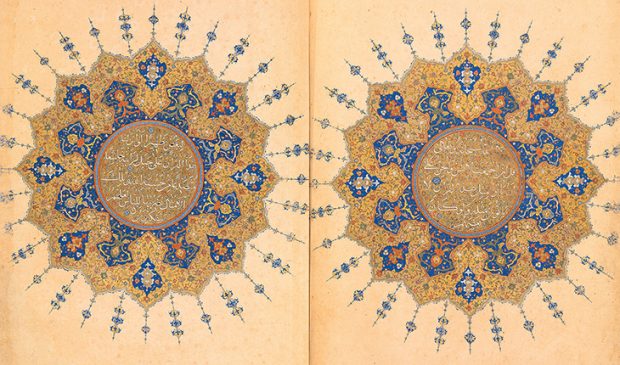
The calligraphy and patterns in this Qur’an from the 16th century emphasise the untranslatability of the classical Arabic text. Bodleian Libraries, University of Oxford
Of no less importance for the development of the theory (and practice) of translation in the West are the Homeric poems. In a long horizontal display case we see a timeline of the poems’ translations, moving from a fragment of the Odyssey written on papyrus to George Chapman’s folio-sized Homer (1616), immortalised by Keats, and Alexander Pope’s Iliad (1771), the work that Dr. Johnson claimed ‘tuned the English tongue’, the frontispiece of which grandiosely juxtaposes a bust of the ancient bard with an engraving of the modern poet.
The Homer material is the fullest case study, since it presents us not only with these traditional translations, but also, at the case’s beginning and its end, two of a more figurative sort. One is material: the black-figure depiction of Odysseus’s escape from the cave of the Cyclops on a 6th-century oil jar – an episode that hinges on a play on words (the Greek for ‘nobody’) that is impossible to translate. Another is visual: Christopher Logue’s map-like radio script for War Music, his sublime ‘account’ of the Iliad, written with multicoloured markers and Post-Its over more than a metre of computer paper. The Logue script, like the annotated Bible, allows us to get thrillingly close to the actual mysterious act of translation and to see not just the finished products of translation, but the visually engaging process of annotation, composition, and revision. The curators go to great lengths to approach translation from all sides in an effort to provide the fullest picture possible – but one can forget in ‘Adventures in Translation’ that translation is something that a translator does with a pen.
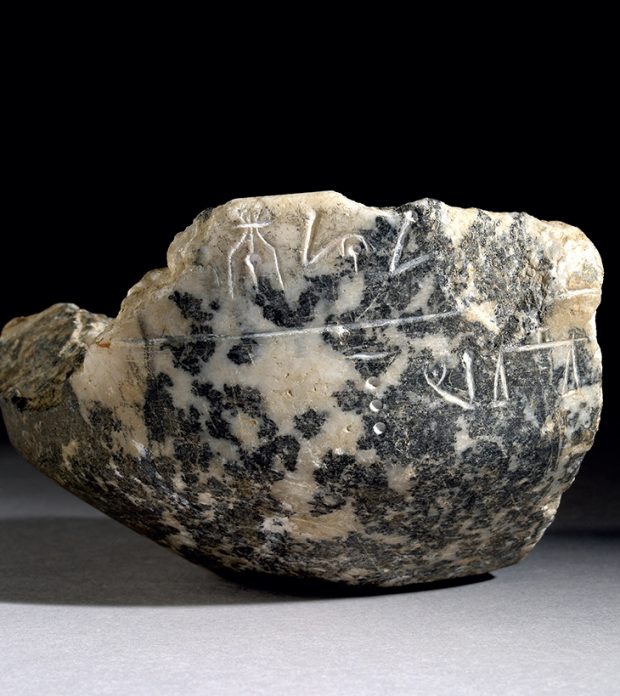
Minoan stone vessel with untranslated inscription in LInear A, c. 1800–c. 1450 BC, excavated by Arthur Evans in Knossos. Ashmolean Museum, Oxford
For the exhibition advocates a tantalisingly broad interpretation of translation. The curators gesture towards a kind of conceptual translation underlying the delicate, leaf-like pop-up diagrams in Henry Billingsley’s English edition of Euclid’s Elements, published in 1570 and the proto-code in Ada Lovelace’s instructions for calculating Bernoulli numbers using Charles Babbage’s Analytical Engine. The quest for an ideal system of representation extends to the language of everyday life, in quixotic attempts at ‘debabilisation’ through perfect or universal languages. In An Essay towards a Real Character, and a Philosophical Language (1668), John Wilkins proposed to further scientific exchange in a baroque squiggle language that would represent things, rather than transcribe language – an effort doomed from the start but, as Borges saw, charming precisely for its impracticality. More than two centuries after Wilkins, the polymath Otto Neurath responded to the political tumult and social change of 1930s with the chunky, functional International Picture Language, a system of hieroglyphs based on universally recognisable symbols that could ease the spread of education to new classes and mutual understanding between cultures. Although Wilkins’ so-called ‘real’ character looks like the past, Neurath’s stripped-down isotypes still look like the future, and live on in the airport signs, street signals, and app interfaces that we encounter daily.
The search for a universal language reflects a utopian vision – but translation also has a darker side, as demonstrated by the Mendoza Codex, a 16th-century Spanish visual dictionary of the indigenous Mexica language. The colourful diagrams of birds and indigenous costume that at first glance seem mysteriously beautiful take on a sinister air after a moment’s reflection: translation can help us cross cultural boundaries, but it can also be wielded as a weapon for conquest.
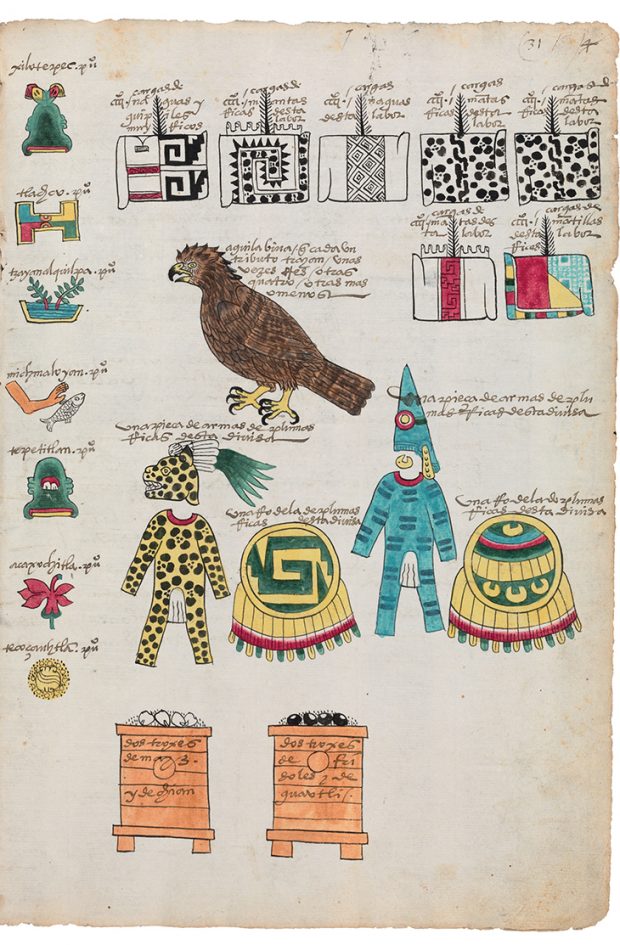
Page from the Codex Mexicana of c. 1541, created for Charles V, Holy Roman Emperor and King of Spain. Here, a description of the tribute owed by seven towns to their rulers in Tenochtitlan. Bodleian Libraries, University of Oxford
Once the language of empire and now the lingua franca of globalisation, translation is inseparable from the history of English. But English has never meant one thing, and there has never been just one language in Britain. In a large display on multilingual Britain is the Oxford Roland, the oldest complete manuscript of La chanson de Roland, the French national epic, that was copied in England and has been at Oxford since the 13th century. This and other medieval multilingual manuscripts are juxtaposed, somewhat jarringly, with a large Welsh-English road sign (‘Work suspended / Unsuitable Weather’), a well-worn modern paperback of Samuel Selvon’s Windrush-generation narrative The Lonely Londoners, and a soon-to-be-historical UK/EU passport.
Looming in the background is Britain’s recent choice to leave the European Union. Yet the tone of ‘Adventures in Translation’ is not so much of despair as of resilience, even resistance. ‘There can be no Brexit for languages,’ reads one of the wall texts (on linguistic change). No matter how much some want to draw a clear line between Britain and the world by dissolving political relationships, defunding language tuition, and stoking resentment and nostalgia, English and the many other languages spoken in the United Kingdom will always bind this small island to Europe and beyond.
‘Babel: Adventures in Translation’ is at the Weston Library, University of Oxford until 2 June.
Unlimited access from just $16 every 3 months
Subscribe to get unlimited and exclusive access to the top art stories, interviews and exhibition reviews.

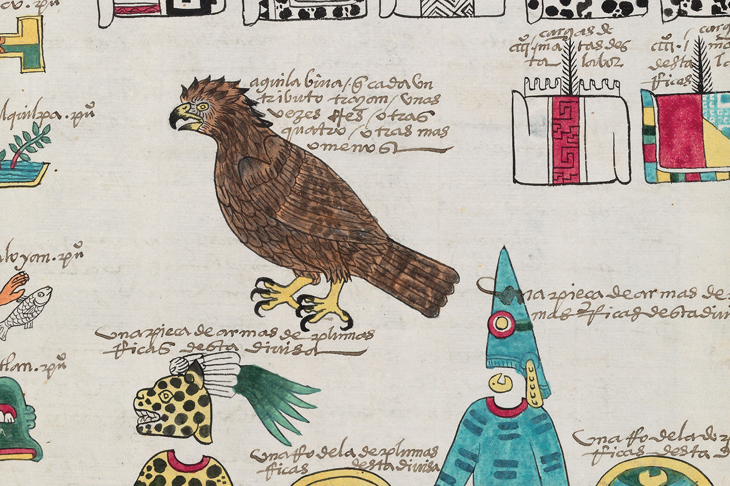
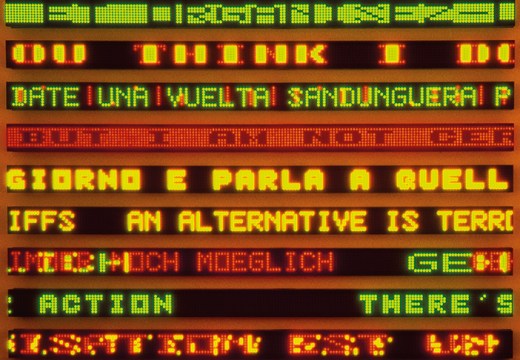
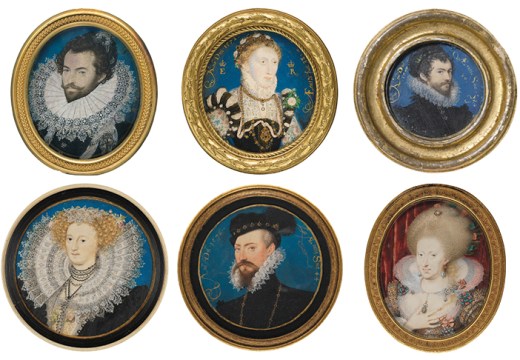
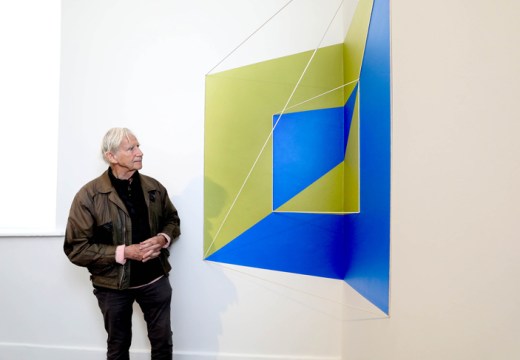









![Masterpiece [Re]discovery 2022. Photo: Ben Fisher Photography, courtesy of Masterpiece London](http://www.apollo-magazine.com/wp-content/uploads/2022/07/MPL2022_4263.jpg)
Is the Stirling Prize suffering from a case of tunnel vision?